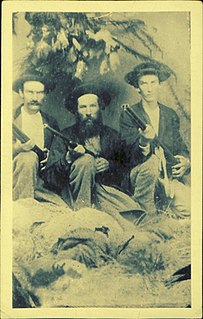
Moss Neck is a community in Robeson County, North Carolina, United States.

Moss Neck is a community in Robeson County, North Carolina, United States.
Moss Neck is located in west-central Robeson County. [1] It began as a center for turpentine distillation, though as local pine forests were depleted the industry moved south. The community remained due to the presence of a post office and a cooperage. [2] In January 1861, the Wilmington, Charlotte and Rutherford Railroad built a line through the village. [3] A railway station was established, leading to a revitalization of the local community, and it became a center of Lumbee activity. [4] It was frequented by members of the Lowry Gang during the Lowry War. [5] In 1892, the Wilmington and Weldon Railroad proposed building a north-south line through Moss Neck, but at the opposition of a prominent citizen the line was moved a few miles west to Campbell's Mill, which shortly thereafter became Pembroke. [6] The station at Moss Neck was later closed. [7]

The Tuscarora are a Native American tribe and First Nations band government of the Iroquoian family, with members today in New York, USA, and Ontario, Canada. They coalesced as a people around the Great Lakes, likely about the same time as the rise of the Five Nations of the historic Iroquois Confederacy, also Iroquoian-speaking and based then in present-day New York.

Robeson County is a county in the southern part of the U.S. state of North Carolina. As of the 2010 census, the population was 134,168. Its county seat is Lumberton. The county was formed in 1787 from part of Bladen County. It was named in honor of Col. Thomas Robeson of Tar Heel, a hero of the Revolutionary War.

Lumberton is a city in Robeson County, North Carolina, United States. It is the county seat of Robeson County, which is the largest county in the state by land area.

Pembroke is a town in Robeson County, North Carolina, United States. It is about 90 miles inland and northwest from the Atlantic Coast. The population was 2,973, at the 2010 census. The town is the seat of the state-recognized Lumbee tribe of North Carolina, as well as the home of The University of North Carolina at Pembroke.

Prospect is a census-designated place (CDP) in Robeson County, North Carolina, United States. The population was 690 at the 2000 census. Located due northeast of Pembroke, Prospect is a traditionally Methodist community, with its church members largely becoming representatives for the entirety of the American Indian-Methodist community. Prospect is noted for one of its native sons, Adolph Dial, whose contributions to American Indian Studies have led to an heightened awareness of the local Lumbee Tribe and Native Americans throughout the Southeastern United States.

The University of North Carolina at Pembroke is a public university in Pembroke, North Carolina. UNC Pembroke is a master's level degree-granting university and part of the University of North Carolina system. Its history is intertwined with that of the Lumbee nation.

The Lumbee Tribe of North Carolina is a state-recognized tribe in North Carolina numbering approximately 55,000 enrolled members, most of them living primarily in Robeson, Hoke, Cumberland and Scotland counties. The Lumbee Tribe is the largest state tribe in North Carolina, the largest state tribe east of the Mississippi River, and the ninth largest non-federally recognized tribe in the United States. The Lumbee take their name from the Lumber River which winds through Robeson County. Pembroke, North Carolina, is the economic, cultural and political center of the tribe. The Lumbee Tribe was recognized as a Native American tribe by the United States Congress in 1956, under conditions that it agreed to at the time, which did not allow them to have benefits available to other federally recognized tribes. According to the 2000 United States Census report, 89% of the population of the town of Pembroke, North Carolina, identify as Lumbee; 40% of Robeson County's population identify as Lumbee.

Henry Berry Lowry was an American outlaw. He led the eponymous Lowry Gang in North Carolina during and after the American Civil War. Many local North Carolinians remember him as a Robin Hood figure. Lowry was described by George Alfred Townsend, a correspondent for the New York Herald in the late 19th century, as "[o]ne of those remarkable executive spirits that arises now and then in a raw community without advantages other than those given by nature."

The Battle of Hayes Pond, the Battle of Maxton Field, or the Maxton Riot was an armed confrontation between members of a Ku Klux Klan (KKK) organization and Lumbee Indians at a Klan rally near Maxton, North Carolina, on the night of January 18, 1958. The clash resulted in the disruption of the rally and a significant amount of media coverage praising the Lumbees and condemning the Klansmen.
James William "Catfish" Cole was an American soldier and evangelist who was leader of the Ku Klux Klan of North Carolina and South Carolina, serving as a Grand Dragon.

The Lumber River, sometimes referred to as the Lumbee River, is a 133-mile-long (214 km) river in south-central North Carolina in the flat Coastal Plain. European settlers first called the river Drowning Creek, which is the name of its headwater. The waterway known as the Lumber River extends downstream from the Scotland County-Hoke County border to the North Carolina-South Carolina border. Soon after crossing into South Carolina, the Lumber River flows into the Little Pee Dee River, which flows into the Pee Dee River, or Great Pee Dee River. Finally, the combined waters flow into Winyah Bay and the Atlantic Ocean.
Waccamaw Siouan Indians are one of eight state-recognized tribes in North Carolina. They are also known as the "People of the Fallen Star." Historically Siouan-speaking, they are located predominantly in the southeastern North Carolina counties of Bladen and Columbus. Their congressional representative introduced a failed bill for federal recognition in 1948. North Carolina recognized the group in 1971.

The Croatan are a small Native American group living in the coastal areas of what is now North Carolina. They might have been a branch of the larger Roanoke people or allied with them. The Croatan historically lived in current Dare County, an area encompassing the Alligator River, Croatan Sound, Roanoke Island, Ocracoke Island, and parts of the Outer Banks, including Hatteras Island. The Croatan people who exist today live in Cumberland, Sampson, and Harnett counties predominantly.

The Lowry War or Lowrie War was a conflict that took place in and around Robeson County, North Carolina, United States from 1864 to 1874 between a group of mostly Native American outlaws and civil local, state, and federal authorities. The conflict is named for Henry Berry Lowry, a Lumbee who led a gang of American Indian, white and black men which robbed area farms and killed public officials who pursued them.
Christopher Arris Oakley is an American historian who specializes in North Carolina Indians.
The Lumbee Regional Development Association (LRDA) is a non-profit corporation, chartered by the State of North Carolina in 1968, organized to analyze and develop solutions for the health, educational, economic, and general welfare problems of rural and urban Indians in and around Robeson County. The effective domain of the LRDA includes, but is not limited to, the Counties of Robeson, Hoke, Scotland, and Bladen, i.e., North Carolina’s Planning Region N. Federally funded programs are currently administered, by the Lumbee citizens of these neighboring counties from the LRDA offices in Pembroke, North Carolina. Currently, LRDA provides services to over 20,600 people each year. In July 2009, LRDA employed 62 full-time employees.
Adolph Lorenz Dial was an American historian, professor of history at the University of North Carolina at Pembroke, and a specialist in the field of American Indian Studies. Dial was a member of the Lumbee Tribe and a graduate of Pembroke State College, where he obtained a bachelor's degree in social studies. Soon after graduating, Dial enlisted with the United States Army, completing a tour of duty in the European theater of World War II. Post-military, Dial obtained his master's degree and an advanced certificate in social studies from Boston University. Hired by Pembroke State College in 1958, Dial would go on to create the college's American Indian Studies program, the first of its kind at any university in the Southeast. In addition to his role in academia, Dial was a member of the North Carolina House of Representatives for a single term. Over the course of his career, Dial devoted the majority of his academic work towards enriching and publicizing the history of the Lumbee Tribe and its importance within the history of North Carolina, and within the greater narrative of Native American peoples. Dial died on December 24, 1995, 12 days after his 73rd birthday.
Rhoda Strong Lowry, also known as the "Queen of Scuffletown", was a Lumbee Native American woman from North Carolina. She allegedly helped her husband, Henry Berry Lowrie, flee after he and his gang killed many white people in attempt to avenge his father and brother's deaths.
Ruth Dial Woods is an American educator and activist. A member of the Lumbee Tribe of North Carolina, she was the first woman to serve as the associate superintendent of the Robeson County Public Schools and to receive an at-large appointment to the University of North Carolina Board of Governors. After teaching in the public school system of Robeson County for 27 years, she joined the faculty at Fayetteville State University. In addition to her work as an educator, Woods was involved in the Civil Rights Movement, the Women's liberation movement, and the American Indian Movement. She has served as a community development consultant for the United States Department of Labor and as a consultant for the Lumbee Tribal Council for administration of tribal programs. The recipient of numerous awards and honors for her work in human rights and education, in 2011, she was inducted into the North Carolina Women's Hall of Fame.
Pates is a community in Robeson County, North Carolina, United States.